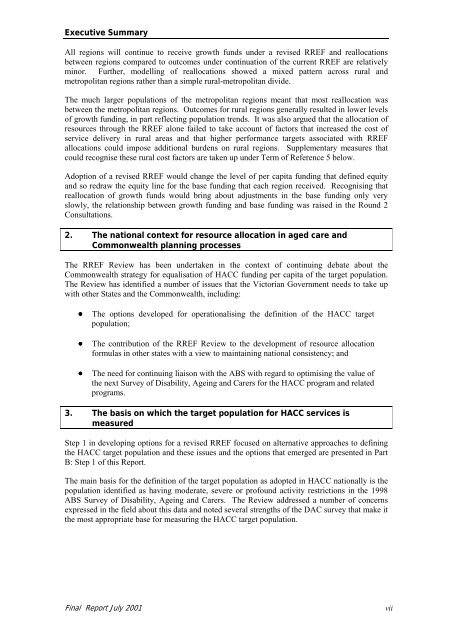Final Report on RREF 2001 - Department of Health
Final Report on RREF 2001 - Department of Health
Final Report on RREF 2001 - Department of Health
Create successful ePaper yourself
Turn your PDF publications into a flip-book with our unique Google optimized e-Paper software.
Executive Summary<br />
All regi<strong>on</strong>s will c<strong>on</strong>tinue to receive growth funds under a revised <strong>RREF</strong> and reallocati<strong>on</strong>s<br />
between regi<strong>on</strong>s compared to outcomes under c<strong>on</strong>tinuati<strong>on</strong> <strong>of</strong> the current <strong>RREF</strong> are relatively<br />
minor. Further, modelling <strong>of</strong> reallocati<strong>on</strong>s showed a mixed pattern across rural and<br />
metropolitan regi<strong>on</strong>s rather than a simple rural-metropolitan divide.<br />
The much larger populati<strong>on</strong>s <strong>of</strong> the metropolitan regi<strong>on</strong>s meant that most reallocati<strong>on</strong> was<br />
between the metropolitan regi<strong>on</strong>s. Outcomes for rural regi<strong>on</strong>s generally resulted in lower levels<br />
<strong>of</strong> growth funding, in part reflecting populati<strong>on</strong> trends. It was also argued that the allocati<strong>on</strong> <strong>of</strong><br />
resources through the <strong>RREF</strong> al<strong>on</strong>e failed to take account <strong>of</strong> factors that increased the cost <strong>of</strong><br />
service delivery in rural areas and that higher performance targets associated with <strong>RREF</strong><br />
allocati<strong>on</strong>s could impose additi<strong>on</strong>al burdens <strong>on</strong> rural regi<strong>on</strong>s. Supplementary measures that<br />
could recognise these rural cost factors are taken up under Term <strong>of</strong> Reference 5 below.<br />
Adopti<strong>on</strong> <strong>of</strong> a revised <strong>RREF</strong> would change the level <strong>of</strong> per capita funding that defined equity<br />
and so redraw the equity line for the base funding that each regi<strong>on</strong> received. Recognising that<br />
reallocati<strong>on</strong> <strong>of</strong> growth funds would bring about adjustments in the base funding <strong>on</strong>ly very<br />
slowly, the relati<strong>on</strong>ship between growth funding and base funding was raised in the Round 2<br />
C<strong>on</strong>sultati<strong>on</strong>s.<br />
2. The nati<strong>on</strong>al c<strong>on</strong>text for resource allocati<strong>on</strong> in aged care and<br />
Comm<strong>on</strong>wealth planning processes<br />
The <strong>RREF</strong> Review has been undertaken in the c<strong>on</strong>text <strong>of</strong> c<strong>on</strong>tinuing debate about the<br />
Comm<strong>on</strong>wealth strategy for equalisati<strong>on</strong> <strong>of</strong> HACC funding per capita <strong>of</strong> the target populati<strong>on</strong>.<br />
The Review has identified a number <strong>of</strong> issues that the Victorian Government needs to take up<br />
with other States and the Comm<strong>on</strong>wealth, including:<br />
• The opti<strong>on</strong>s developed for operati<strong>on</strong>alising the definiti<strong>on</strong> <strong>of</strong> the HACC target<br />
populati<strong>on</strong>;<br />
• The c<strong>on</strong>tributi<strong>on</strong> <strong>of</strong> the <strong>RREF</strong> Review to the development <strong>of</strong> resource allocati<strong>on</strong><br />
formulas in other states with a view to maintaining nati<strong>on</strong>al c<strong>on</strong>sistency; and<br />
• The need for c<strong>on</strong>tinuing liais<strong>on</strong> with the ABS with regard to optimising the value <strong>of</strong><br />
the next Survey <strong>of</strong> Disability, Ageing and Carers for the HACC program and related<br />
programs.<br />
3. The basis <strong>on</strong> which the target populati<strong>on</strong> for HACC services is<br />
measured<br />
Step 1 in developing opti<strong>on</strong>s for a revised <strong>RREF</strong> focused <strong>on</strong> alternative approaches to defining<br />
the HACC target populati<strong>on</strong> and these issues and the opti<strong>on</strong>s that emerged are presented in Part<br />
B: Step 1 <strong>of</strong> this <str<strong>on</strong>g>Report</str<strong>on</strong>g>.<br />
The main basis for the definiti<strong>on</strong> <strong>of</strong> the target populati<strong>on</strong> as adopted in HACC nati<strong>on</strong>ally is the<br />
populati<strong>on</strong> identified as having moderate, severe or pr<strong>of</strong>ound activity restricti<strong>on</strong>s in the 1998<br />
ABS Survey <strong>of</strong> Disability, Ageing and Carers. The Review addressed a number <strong>of</strong> c<strong>on</strong>cerns<br />
expressed in the field about this data and noted several strengths <strong>of</strong> the DAC survey that make it<br />
the most appropriate base for measuring the HACC target populati<strong>on</strong>.<br />
<str<strong>on</strong>g>Final</str<strong>on</strong>g> <str<strong>on</strong>g>Report</str<strong>on</strong>g> July <strong>2001</strong><br />
vii
















